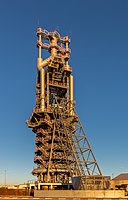
Photo from wikipedia
The high P content in steel slag limits its use in the next heats of steelmaking. Therefore, in this experiment, P2O5-containing slag was reduced by carbon at high temperatures in… Click to show full abstract
The high P content in steel slag limits its use in the next heats of steelmaking. Therefore, in this experiment, P2O5-containing slag was reduced by carbon at high temperatures in the flowing N2 and P-containing substances in the off-gas were water-cooled and collected. Both XRD analysis and thermodynamic calculations indicate that the reduction products are mainly composed of P2. The analysis with scanning electron microscope shows that the plate-like 2CaO·SiO2 and 3CaO·SiO2 phases in the steel slag were smashed into granular shape by the gas (P2 and CO) generated during the reduction. The reduction of P2O5 in the P-rich 2CaO·SiO2 and 3CaO·SiO2 phases in the steel slag is insufficient, while that in P-lean RO phase is complete. The single-factor experiments proves that the phosphorus vaporization rate increases with the moderate increase in temperature, FeO content and N2 flow rate, but decreases with the increase in of basicity.
Journal Title: Transactions of the Indian Institute of Metals
Year Published: 2019
Link to full text (if available)
Share on Social Media: Sign Up to like & get
recommendations!